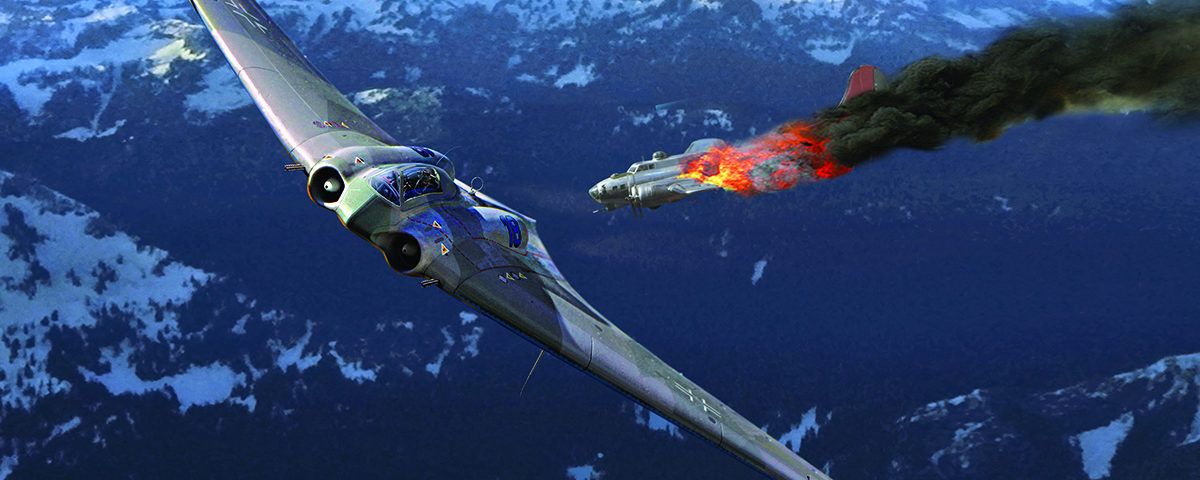Reimar Horten and his older brother Walter were German aircraft homebuilders. Their relatively short aircraft-building careers extended from 1933 until the end of World War II, though they did some minor work in Argentina after the war as expatriate Nazis. Had they lived 40 years later, chances are they would have been busy members of an EAA chapter in Germany, making a living selling kits for their high-performance flying-wing sailplanes.
The Hortens weren’t Burt Rutans. Talented, yes, but not the aeronautical geniuses they’ve been called by some. They built a series of increasingly sophisticated iterations of the same basic design—graceful sweptwing, tailless gliders, though several of their wings were powered. The Hortens produced a grand total of 44 airframes of their dozen basic designs. History has portrayed them as aeronautical visionaries, for in 1940 Messerschmitt Me-109 pilot Walter Horten, who scored seven Battle of Britain victories as Adolf Galland’s wingman, proposed putting a pair of Germany’s new axial-flow jet engines into a Horten glider. The result was the Ho IX. (Brother Reimar was the aerodynamicist and designer; Walter was the facilitator, eventually holding an important Luftwaffe position that allowed him to divert government supplies, staff and facilities for his brother.)
The jets were first going to be two BMW 003s, but when they underperformed the Hortens switched to Junkers Jumo 004Bs. The Ho IX V2 (Versuch 2, or Test 2—the V1 was an unpowered research glider) officially flew three times, crashing fatally at the end of the third flight when one of its two Jumos failed.
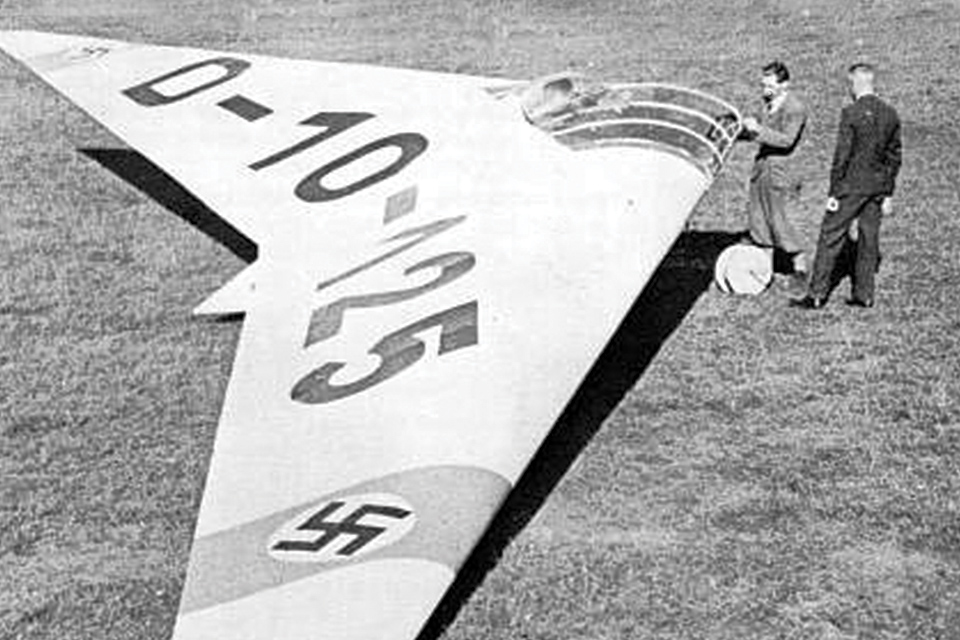
No Horten IX ever flew again, but the brothers had undeniably built and tested the world’s first turbojet flying wing. The Ho IX V2 first flew in March 1945, more than three and a half years before Northrop’s eight-jet YB-49 flying-wing bomber took off. In a number of ways, the Hortens were well ahead of Jack Northrop and his engineers, though Northrop never admitted that. After the war, it was suggested to Northrop that he hire the brothers. “Forget it, they’re just glider designers,” he said condescendingly. The success of the Ho IX was pointed out to him, but Northrop dismissed it as a Gotha design, not a Horten.
Northrop was wrong, but the source of his confusion was the fact that the Luftwaffe, knowing the tiny Horten garage operation could never mass-produce twin-engine jet fighter-bombers, turned the project over to Gotha, a large railroad car manufacturing company with aircraft-building experience. As a result, the Horten jet has come down to us with a confusing suite of names. The actual sole jet-powered wing that flew was the Ho IX V2. The German air ministry (Reichsluftfahrtministerium, or RLM) gave the project an official make and model designation—Ho-229. Because production was assigned to Gotha, some sources still refer to the airplane as a Go-229. Many Luftwaffe aircraft were built by a variety of manufacturers, but a Junkers remained a Ju, a Heinkel an He, a Dornier a Do no matter who actually manufactured it, so “Go-229” is a misnomer. The Smithsonian’s National Air and Space Museum, citing the RLM designation, calls a major artifact in its collection that is about to undergo serious conservation a Horten 229. This despite the fact that no production Horten 229 ever existed; what the Smithsonian has is the never-completed Ho IX V3 built by Gotha.
It bears mentioning that neither Northrop nor the Hortens invented flying wings. Both the concept and actual flying wings have been around since the 1910s. In fact, by the late 1920s, there had been enough experiments with flying wings that the configuration was considered passé, and both Jack Northrop and the Hortens were late to the party.
The Hortens have also been credited with designing and building the world’s first stealth fighter. That is a more difficult claim to support. It’s a popular fiction in the “Hitler’s wonder weapons” community, and it got a boost in a 2009 Northrop Grumman–sponsored film, Hitler’s Stealth Fighter, a National Geographic documentary. The doc tried to show that a modern replica of the National Air and Space Museum’s Ho IX V3 bombarded by microwaves revealed moderate radar-deflecting properties. Northrop Grumman’s prototyping shop built the replica for $250,000. That’s a bargain for an hour-long video broadcast on the History Channel that is still being discussed by what some call the “Napkinwaffe”—a dig at where the plans for some of the Luftwaffe’s fantasy fighters were first sketched. (Engineering drawings for the Horten jet reveal this to be not far from the truth.)
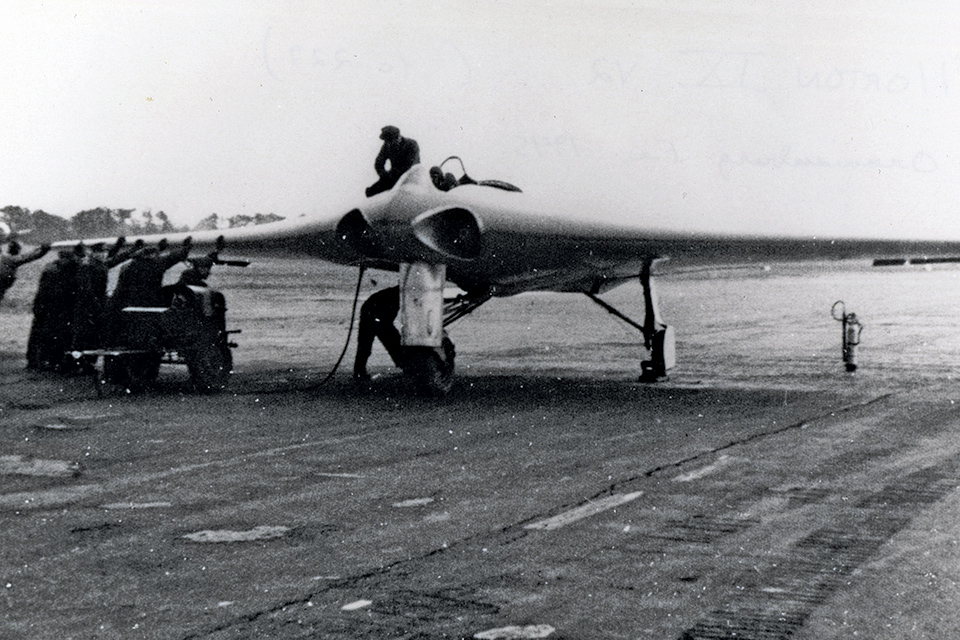
Northrop Grumman built the Horten replica entirely of wood, its plywood skins layered with radar-absorbent carbon-impregnated glue. Only the externally radar-visible instrument panel backing and first-stage compressor disks were metal. Yet the Horten brothers’ original airplane also had an 11-foot-wide center section made of welded steel tubing, and it carried two turbojet engines. Neither of these were part of the Northrop Grumman replica. It could be argued that all this metal might have reflected at least some microwave energy that penetrated the plywood. But Northrop Grumman felt that their special glue made the replica totally opaque to radar.
The replicators also left out the original Ho IX V3’s eight large aluminum fuel tanks. Nor did Northrop Grumman include the underwing bombs that would have been necessary for any attack on a radar-defended target. Externally racked ordnance destroys any semblance of stealth. The Nat Geo film ended up suggesting that an all-wood Horten might have been able to do a fly-by of Britain’s by then obsolete Chain Home low-frequency radar array, but it wouldn’t have been able to bomb anything.
Narration over the film says that it reveals “just how close Nazi engineers were to unleashing a jet that some say could have changed the course of the war.” Not bloody likely, if only because by that time, the Germans were literally out of gas.
The heart of the Horten stealth assertion is a claim by the brothers, made long after the war ended, that they indeed had intended to fasten the layers of the Ho-229’s plywood sheathing with glue mixed with radar-absorbing charcoal. Perhaps they did mean to do that, but the first mention of this plan came in a 1983 book written by Reimar, at a time when the basics of U.S. stealth technology were becoming public knowledge. There is no mention of any attempt to achieve stealthy properties for the Ho-229 by anybody involved in the actual fabrication of the prototypes.
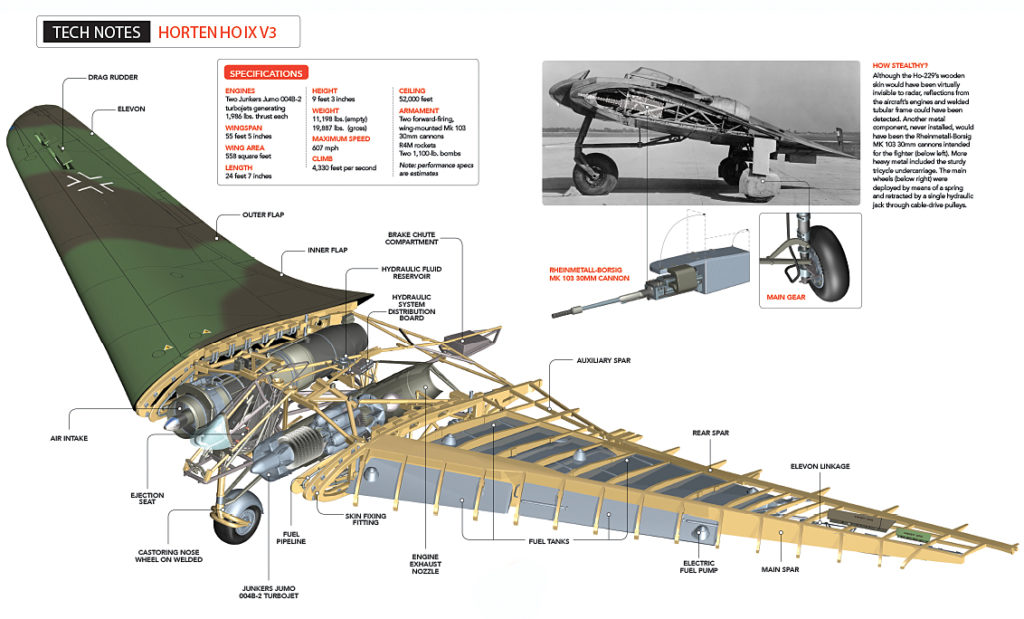
NASM’s restoration facility ran extensive digital-microscopy, X-ray diffraction and Fourier-transfer spectroscopy tests on the wooden structure of their Horten aircraft’s wing and found no evidence of any carbon or charcoal impregnation of the glue. The black specks that Northrop Grumman had assumed were evidence of the Hortens’ attempt to create a radar blanket were found to be simply oxidized wood.
Reimar Horten originally planned to sheathe the Ho IX in aluminum, which hardly suggests that he had stealth as an objective. It was only when he discovered to his surprise that the Messerschmitt Me-163 rocket plane was covered in plywood that he realized high speed didn’t rule out using wood. He then switched to more easily obtainable plywood veneer, but for reasons that had nothing to do with its radar attenuation and everything to do with its availability.
It’s also worth noting that the Ho-229 was intended to be a day fighter, a bomber interceptor, though eventually, as was true of so many Luftwaffe fantasy fighters, it was to undertake a variety of other roles. Walter Horten had originally advocated jet power because, as a fighter pilot himself, he wanted to build a better airplane than the Focke Wulf Fw-190, which he considered to be an inferior, spin-prone design.
So why would stealth have been a criterion, if an Ho-229 would never confront radar? It wasn’t. Hitler’s “stealth fighter” was simply intended to be Hitler’s aerodynamically efficient, fast, maneuverable fighter.
GET HISTORY’S GREATEST TALES—RIGHT IN YOUR INBOX
Subscribe to our HistoryNet Now! newsletter for the best of the past, delivered every Monday and Thursday.
How did the Hitler’s stealth fighter myth take root? Certainly there’s fertile ground upon which such legends can be sown among the model builders and war gamers who love nothing more than mysterious Luftwaffe wonder weapons that would have reversed the course of the war had it only lasted another month. But none seem to understand the years-long prototyping/testing/production process that is a necessary part of bringing a sophisticated aircraft from napkin sketch to combat. Exactly three years and a day passed between the Messerschmitt Me-262 twin-jet’s first flight and the beginning of its operational readiness. Following such a schedule, the Ho-229 would have been ready for combat in early 1948.
The Ho IX, precursor of the 229, was the work of a garage shop. The V1 and V2 versions were built in what was essentially a three-car workshop, out of largely unairworthy structural material. The center section steel tubing was much like what today suffices for building trade electrical conduit, and the Hortens were notorious for using household-grade plywood veneer for their airplanes’ external sheathing.
How professional were the Hortens? Some of their work raises questions. Walter Horten was assigned the job of calculating the V2’s center of gravity, for example, which he did using a steel measuring tape. Unfortunately, he never noticed that the first 10 centimeters of the tape had broken off, so his false measurements determined that the airplane needed substantial ballast in the nose. Since the CG was 10 centimeters off, the test pilot assigned to the first flight found that he could barely keep the airplane aloft with full back stick, and when he tried to flare for landing the airplane hit so hard that it badly damaged the gear. And the Hortens’ fabricators welded and rewelded the V2’s center section as the engine choice flip-flopped between BMW and Junkers, which created heat stresses that no experienced aircraft builder would have allowed. Skilled welders would have cut out and rebuilt entire sections of the structure.
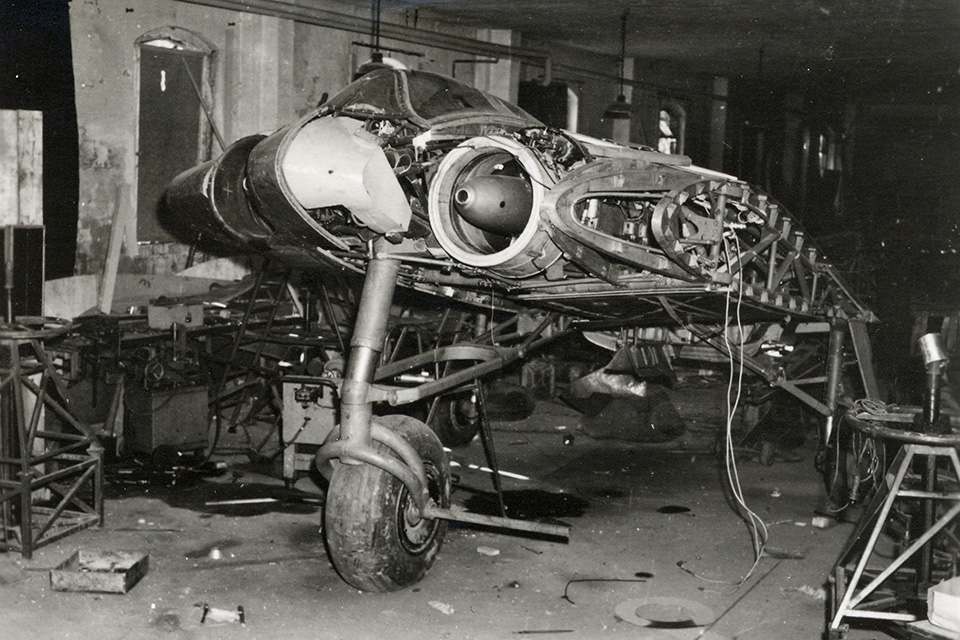
The Hortens also needed to adapt cast-off components to their Ho IX airframe, which led to its ungainly nosewheel. The airplane’s main gear is fashioned from Me-109 parts, and the enormous nosewheel, almost 5 feet in diameter, is the tailwheel, tire and retraction mechanism from a Heinkel He-177 Greif, a benighted heavy bomber. It was a fortuitous choice nonetheless. The oversize nosewheel put the Ho IX at a 7-degree angle of incidence at rest, which facilitated takeoff without requiring the forceful rotation other Horten designs had needed.
After the war, a number of Horten designs were examined by the Allies, initially the British. If any conspiracy theorists noticed the byline at the beginning of this article, they’ll by now be hyperventilating, for the “Wilkinson Report,” written by a committee of British aviation authorities headed by soaring expert Kenneth Wilkinson, was supposedly highly critical of the Hortens. (If Kenneth and I are related, it is to the same degree that Henry and Harrison Ford are.)
British aviation writer Lance Cole, apparently a serious Horten conspiracist, wrote that the Wilkinson Report was “a way of helping to shield the reality of the Horten achievement so that greater powers could seize the ideas and keep them unseen for decades…[it] dismissed their ideas and works as apparent flights of fancy; stemming, it seemed, from what felt like a British attitude of the Hortens being men ‘without the proper background.'”
I can find none of this in the evenhanded, rigorous, authoritative, technical 60-page Wilkinson Report. The paper does point out that British engineers tended to trust wind-tunnel data more than they did inflight assessments, but admits the Hortens had no access to such a tunnel. It calls the Hortens’ careers “a remarkable record of progress in spite of [such] obstacles.”
One thing that did baffle Wilkinson’s committee was that so little of Reimar Horten’s work was of the slightest use to the German war effort. Reimar was far more interested in record-setting and competition gliders, and he continued to design and build them throughout the war. Some historians, in fact, think that he viewed the jet wing as a “flying résumé” that would help him get a job in the U.S. or Britain after the war. Reimar would have loved to carry on his career in the States. Despite membership in the Nazi Party and his work as a Luftwaffe assault-glider instructor, he had first tried to emigrate to America in 1938 but had been refused an exit visa since he was thought to have had access to classified information.
Why a flying wing? What’s wrong with the conventional designs that have served so well since the early 1900s? Certainly there have been some useful variations—canards, pushers, semi-tailless deltas, blended wing/body proposals, even Vincent Burnelli’s perennial lifting-fuselage concept—but the pure flying wing has always been an outlier. What is its appeal?
Theoretically, the advantages of a flying wing are substantial. A conventional design—a Boeing 777, a Cessna Skyhawk, an F-22 Raptor, you name it—has wings that contribute lift despite inevitable induced and parasitic drag…plus a fuselage, engine nacelle(s) and an empennage that contribute nothing but drag. Zero lift. Indeed a conventional horizontal stabilizer often adds negative lift—downforce—to an airplane. Yes, the fuselage can carry passengers, cargo or ordnance, but so can a flying wing.
One of the major functions of a fuselage is to support the empennage that provides pitch and yaw control for a conventional airplane. A flying wing totally eliminates the drag of an aft fuselage and empennage. In fact, every part of a flying wing is a lifting surface. An all-wing aircraft also allows for the efficiency of span-loading. Much of a conventional airplane’s weight is concentrated near its centerline, hence the videos of bendy-wing Boeing Dreamliners looking as though they’re trying to clap hands above their fuselages. The forces concentrated at the wing/fuselage juncture of a conventional airplane are enormous, while a flying wing can spread the entire load from wingtip to wingtip, thus allowing for a lighter and more efficient structure. The weight is spread out where the lift is, so a flying wing can have a large, efficient, high-aspect-ratio span without requiring a heavy framework to support it.
For a stealthy airplane, a true flying wing has a distinct advantage: It does away with all radar-reflective vertical surfaces, particularly stabilizers and rudders. This, plus its wooden construction and lack of radar-reflecting prop discs, is what gave Northrop Grumman’s Ho IX replica its comparatively small radar cross-section, not a miracle glue.
The disadvantage of a flying wing is its natural instability, with no tail to provide counterbalance in pitch and yaw. The Hortens overcame much of this with enlightened wing, airfoil and control-surface design, but their airplanes still exhibited the classic flying-wing waddle, semi-technically termed Dutch roll. The Ho IX V2’s flights had already revealed moderate lateral instability. It would have made the Ho-229 a dreadful gun platform as a fighter and a handful as a bomber. (This was the characteristic that doomed the Northrop YB-49 flying wing in its competition with what became the Convair B-36; bomb-run accuracy was impossible to achieve when yaw/roll coupling determined the meandering flight path. Nor did it help that one YB-49 went out of control and crashed fatally during stall testing in June 1948.)
By the time Gotha took over the Ho-229 project, the Horten brothers had lost interest and moved on to their planned masterpiece—a six-turbojet flying wing “Amerika Bomber.” The Ho XVIII never was built, but it filled another niche in the Napkinwaffe. Some still say the Amerika Bomber (several German airframers were racing to build one) was intended to drop an atomic bomb on New York. Fortunately, the Germans would never have been able to build such a weapon, having lost their Norwegian deuterium source, but they did have the capability to put together a dirty bomb—a large conventional bomb encased in strongly radioactive material that would have polluted a wide area with radiation.
Though Northrop wanted nothing to do with the Horten brothers, the company did acquire several of their gliders for research after WWII, leading conspiracists to claim that Northrop stole the Hortens’ secrets for its own flying wings. Actually, Northrop depicted an Ho VI glider in postwar aviation magazine ads as an example of “one of the Nazi attempts to adapt U.S. flying-wing design for eventual military use.”
The Smithsonian’s Ho IX V3 was brought to America as part of Operation Seahorse, a U.S. Navy counterpart to the better-known Operation Paperclip campaign to acquire as many interesting Luftwaffe aircraft as possible. But it was never flown and in fact was only half-completed. It was first assessed at the Royal Aircraft Establishment, in Britain—the source of the Wilkinson Report data—and was then sent to both Wright and Freeman fields for Army Air Forces scrutiny. The jet wing ended up stored outdoors in Chicago at a facility that was intended to become a national air museum. In 1952 the Smithsonian acquired the airplane, though it was by then badly beaten up by numerous moves and exposure to the weather. It was moved once more to “a secret government warehouse,” according to published reports. That warehouse was actually the Smithsonian’s quite unsecret Suitland, Md., restoration facility, where it stayed for 60-plus years, part of that time stored in an open wooden shed.
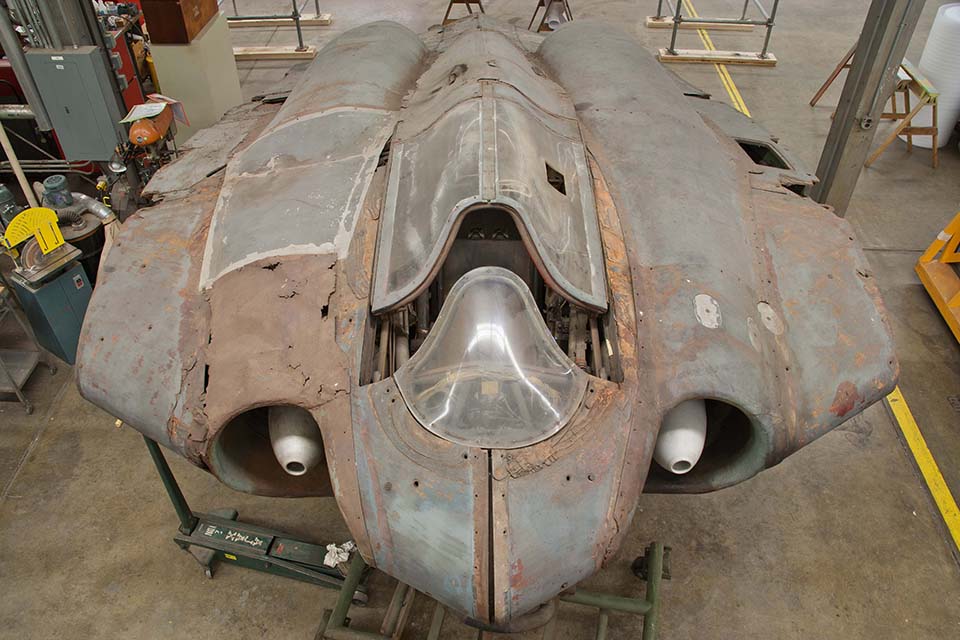
The artifact is in sad shape today, much of its plywood sheathing delaminated and rotting, its metal frame and landing gear corroded, and parts missing. NASM has it on the short list for major work, and the V3 can currently be seen at the museum’s restoration facility in the Udvar-Hazy Center at Dulles Airport.
That work will not be restoration but conservation: stopping the rot and corrosion, cleaning up the airframe and assembling the center section and outer wings into a single unit. Those wings may or may not have been part of the V3. Only one wing came to the U.S. with the center section, and another was later found some distance from the Gotha shop.
The Hortens’ last hurrah took place without their participation. In July 1947, there was a notorious occurrence at Roswell, N.M, known forever after as the “Roswell Incident.” It allegedly involved the crash of a flying saucer and the snatching by the Army Air Forces of the bodies of three aliens aboard it. The Roswell Incident engendered decades’ worth of tabloids portraying the gourd-headed ETs perhaps still stored in freezers in a heavily guarded Area 51 hangar. The government tried to explain away the crash by saying it had been a high-altitude weather balloon; it was actually a secret surveillance balloon intended to keep track of Soviet atomic bomb testing. But some observers with more specialized knowledge had an intriguing theory.
In 1937, Reimar Horten decided that the ultimate flying-wing shape would be a parabola—a wing with a near-circular leading edge planform, which would provide the minimum induced drag and maximum lift. The Hortens built just one parabola-wing glider but never flew it; the airplane was torched after warping and becoming unglued during winter storage. But wait, there’s more: Supposedly the AAF found out about the Horten parabola wing and decided to build a powered version to secretly test Reimar’s theory. It was this airplane, looking uncannily like two-thirds of a flying saucer, that crashed in New Mexico in 1947.
Nobody has yet explained the aliens, however.
For further reading, contributing editor Stephan Wilkinson recommends: The Horten Brothers and Their All-Wing Aircraft, by David Myhra; and Horten Ho 229 Spirit of Thuringia: The Horten All-Wing Jet Fighter, by Andrei Shepelev and Huib Ottens.
This feature originally appeared in the November 2016 issue of Aviation History Magazine.
historynet magazines
Our 9 best-selling history titles feature in-depth storytelling and iconic imagery to engage and inform on the people, the wars, and the events that shaped America and the world.


